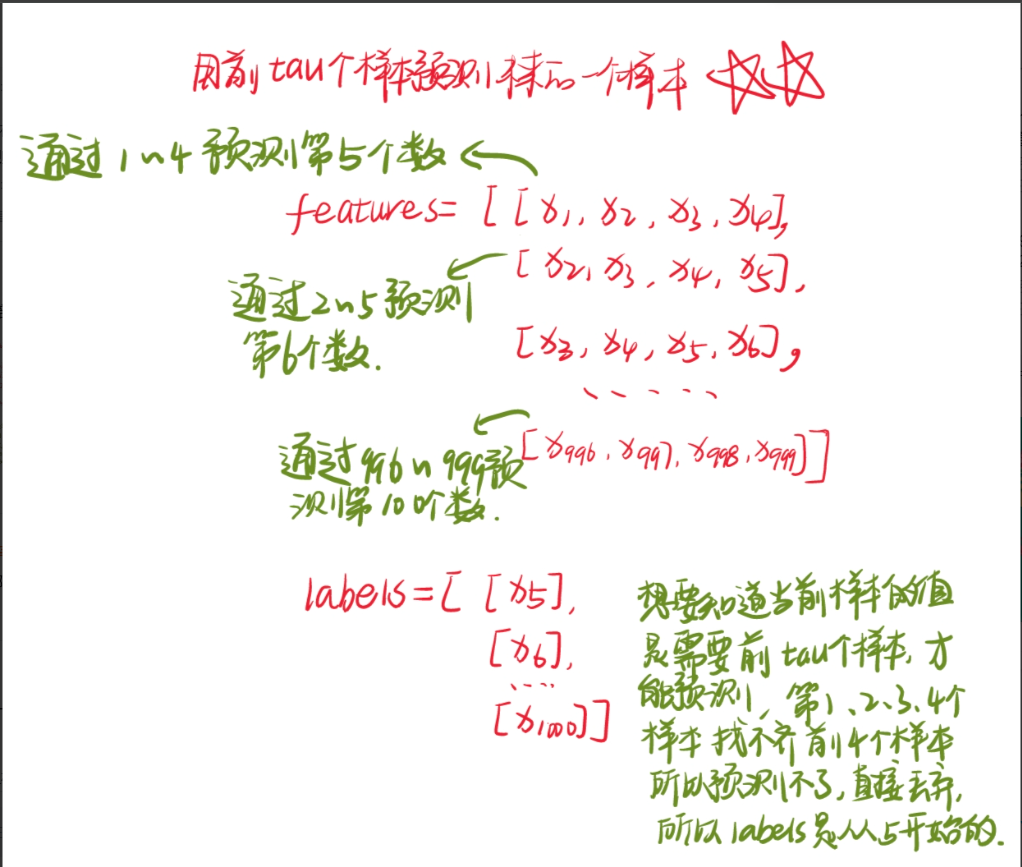
# -*- coding: utf-8 -*-
"""Untitled1.ipynb
Automatically generated by Colab.
Original file is located at
https://colab.research.google.com/drive/1byjQCo1C6lrYYDYihyxfNeSop1tWlGwV
"""
!pip install d2l
# Commented out IPython magic to ensure Python compatibility.
# %matplotlib inline
import torch
from torch import nn
from d2l import torch as d2l
# 总时间步数
T = 1000
# 创建一个从1到T的张量
time = torch.arange(1, T + 1, dtype = torch.float32) # 1到1000为时间
# 生成频率为0.01的正弦波并加入随机噪声
x = torch.sin(0.01 * time) + torch.normal(0, 0.2, (T,))
# 绘制数据
d2l.plot(time, [x], 'time', 'x', xlim=[1,1000], figsize=(6,3))
# 延迟时间步长
tau = 4
# 创建一个形状为(T - tau, tau)的零张量作为特征
features = torch.zeros((T - tau, tau)) # T - tau 为样本数,tau 为特征数
# 每四个数据作为特征,第五个作为标签,不断构造这样的数据形成数据集
for i in range(tau):
# 每四个数据作为特征,第五个作为标签,不断构造这样的数据形成数据集
features[:, i] = x[i:T - tau + i]
# 所从第5个时刻开始,每个时刻的label是该时刻的x值,该时刻的输入是前4个时刻的数值组成的一个向量。
# 经过变化后数据的输入共有996组4个一组的数据,输出共996个值
# 提取标签数据并进行形状变换
labels = x[tau:].reshape((-1,1))
# 批量大小和训练样本数量
batch_size, n_train = 16, 600
# 使用 features 和 labels 的前 n_train 个样本创建一个可迭代的训练集
train_iter = d2l.load_array((features[:n_train],labels[:n_train]),
batch_size, is_train=True)
def init_weights(m):
# 如果当前模块是线性层
if type(m) == nn.Linear:
# 初始化权重函数
nn.init.xavier_uniform_(m.weight)
def get_net():
# 定义神经网络结构
net = nn.Sequential(nn.Linear(4,10),nn.ReLU(),nn.Linear(10,1))
# 对网络的权重进行初始化
net.apply(init_weights)
# 返回构建好的神经网络模型
return net
# 定义均方误差损失函数
loss = nn.MSELoss()
def train(net, train_iter, loss, epochs, lr):
# 定义优化器
trainer = torch.optim.Adam(net.parameters(), lr)
# 迭代训练指定的轮数
for epoch in range(epochs):
# 遍历训练集中的每个批次
for X, y in train_iter:
# 梯度清零
trainer.zero_grad()
# 前向传播计算损失
l = loss(net(X), y)
# 反向传播求梯度
l.backward()
# 更新模型参数
trainer.step()
# 打印当前轮次的损失
print(f'epoch {epoch + 1}, '
f'loss: {d2l.evaluate_loss(net, train_iter, loss):f}')
# 创建神经网络模型
net = get_net()
# 训练模型
train(net, train_iter, loss, 5, 0.01)
# 对特征进行一步预测
onestep_preds = net(features)
# 进行数据可视化,将真实数据和一步预测结果绘制在同一个图中进行比较
d2l.plot([time, time[tau:]],
[x.detach().numpy(), onestep_preds.detach().numpy()], 'time', 'x',
legend = ['data','l-step preds'], xlim = [1, 1000], figsize=(6,3))
# 初始化多步预测结果的张量
multistep_preds = torch.zeros(T)
# 将已知的真实数据赋值给多步预测结果
multistep_preds[:n_train + tau] = x[:n_train + tau]
# 对剩余时间步进行多步预测
for i in range(n_train + tau, T):
# 获得多步预测结果
multistep_preds[i] = net(multistep_preds[i - tau:i].reshape((1,-1)))
# 进行数据可视化
d2l.plot(
[time, time[tau:], time[n_train + tau:]],
[x.detach().numpy(), onestep_preds.detach().numpy(), multistep_preds[n_train + tau:].detach().numpy()],
'time',
'x',
legend = ['data', '1-step preds', 'multistep preds'],
xlim=[1,1000],
figsize=(6,3) )
# 最大步长
max_steps = 64
# 初始化特征张量
features = torch.zeros((T - tau - max_steps + 1, tau + max_steps))
# 从 0 到 tau-1进行遍历
for i in range(tau):
# 构造特征矩阵
features[:, i] = x[i:i + T - tau - max_steps + 1]
# 从 tau 到 tau + max_steps - 1,通过 net(features[:, i - tau:i]) 进行多步预测
for i in range(tau, tau + max_steps):
# 进行多步预测并更新特征矩阵
features[:,i] = net(features[:, i - tau:i]).reshape(-1)
# 预测的步长
steps = (1, 4, 16, 64)
# 进行数据可视化
d2l.plot([time[tau + i - 1:T - max_steps + i] for i in steps],
[features[:, (tau + i - 1)].detach().numpy() for i in steps],
'time',
'x',
legend = [f'{i}-step preds' for i in steps],
xlim = [5,1000],
figsize=(6,3) )

